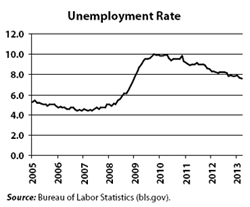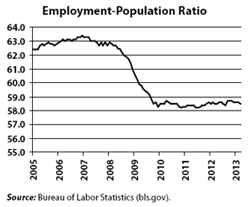Welcome to DU!
The truly grassroots left-of-center political community where regular people, not algorithms, drive the discussions and set the standards.
Join the community:
Create a free account
Support DU (and get rid of ads!):
Become a Star Member
Latest Breaking News
General Discussion
The DU Lounge
All Forums
Issue Forums
Culture Forums
Alliance Forums
Region Forums
Support Forums
Help & Search
Economy
Related: About this forumUnemployment Is Down, So What’s the Problem?
from Dollars & Sense:
Unemployment Is Down, So What’s the Problem?
By Alejandro Reuss | May/June 2013
The “headline” unemployment rate, or U-3 by its Bureau of Labor Statistics (BLS) designation, has declined from a peak of 10.0% in late 2009 to 7.5% now. The unemployment rate—the number of unemployed people as a percentage of the labor force (the employed plus unemployed)—is still abnormally high. Before the onset of the current crisis, it had been this high for only five months (May-September 1992) in the last 24 years.
Unemployment Rate, 2005-2013
The jobs situation now is certainly drastically different from 2008-2010, when unemployment was increasing dramatically—there’s no argument about that. At the bleakest point of the recession, in each of two consecutive months (January-February 2009), over half a million more people went from being employed to unemployed than from unemployed to employed. In March 2013, in contrast, over 250,000 more people went from being unemployed to employed than the reverse. But the end of the employment freefall is hardly the same thing as a robust recovery.
Employment-Population Ratio, 2005-2013


The trend in the employment-to-population ratio—a much less familiar indicator than the headline unemployment rate—tells a different tale. This figure is the number of employed individuals as a percentage of the working-age civilian noninstitutional population. The civilian noninstitutional population excludes military personnel, people in prison, and so on. Working age, meanwhile, is defined as 16 years and over. So there are two big differences between this measure and the unemployment rate. First, the numerator is employment rather than unemployment (so it's looking at the other side of the employment coin). Second, the denominator is not the labor force (the employed plus the unemployed), but the civilian noninstitutional population (which also includes people who are not in the labor force, or NLF). Here, we see not an employment situation that has turned decisively toward recovery, but that has flatlined for more than three years.
Employed, Unemployed, or Neither
How can the unemployment rate have gone steadily down for about three years with hardly a budge to the employment-population ratio? Shouldn’t the two move in opposite directions? To get a handle on this, we have to look at the way the “headline” unemployment rate is calculated, starting with the official government definition of unemployment. .......................(more)
The complete piece is at: http://www.dollarsandsense.org/archives/2013/0513reuss.html
InfoView thread info, including edit history
TrashPut this thread in your Trash Can (My DU » Trash Can)
BookmarkAdd this thread to your Bookmarks (My DU » Bookmarks)
4 replies, 1085 views
ShareGet links to this post and/or share on social media
AlertAlert this post for a rule violation
PowersThere are no powers you can use on this post
EditCannot edit other people's posts
ReplyReply to this post
EditCannot edit other people's posts
Rec (0)
ReplyReply to this post
4 replies
 = new reply since forum marked as read
Highlight:
NoneDon't highlight anything
5 newestHighlight 5 most recent replies
= new reply since forum marked as read
Highlight:
NoneDon't highlight anything
5 newestHighlight 5 most recent replies
Unemployment Is Down, So What’s the Problem? (Original Post)
marmar
May 2013
OP
ChairmanAgnostic
(28,017 posts)1. we can be grateful that we are not Greece.
60% unemployment among their youth?
LiberalEsto
(22,845 posts)2. But the jobs are mostly McJobs, and certain populations aren't being hired
African-Americans have a far higher unemployment rate. People 50 and older also struggle to find jobs, and anyone who has been out of work for more than a year is pretty much screwed.
NV Whino
(20,886 posts)3. It hasn't tricked down to my yet.
FogerRox
(13,211 posts)4. Part time workers went up, full time went down
Add it up, un(der)employed is about 26 million. U6 went up was 13.8% now 13.9%, thats nearly 22 million right there.